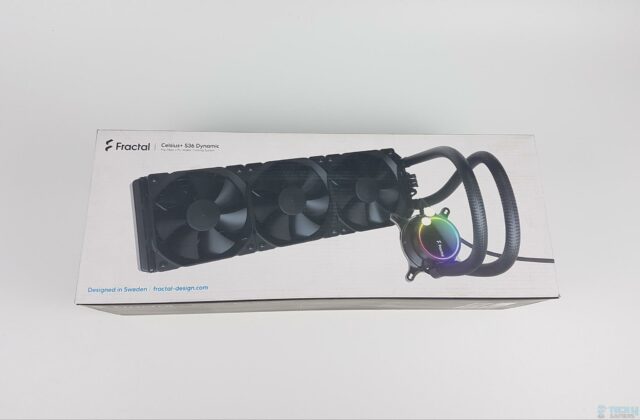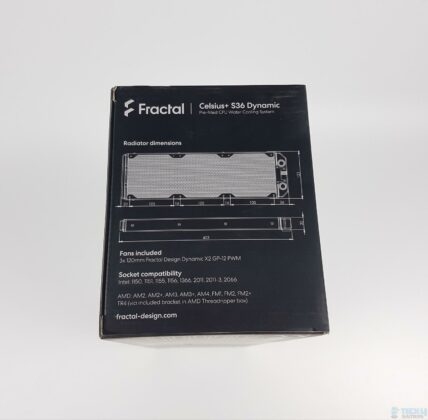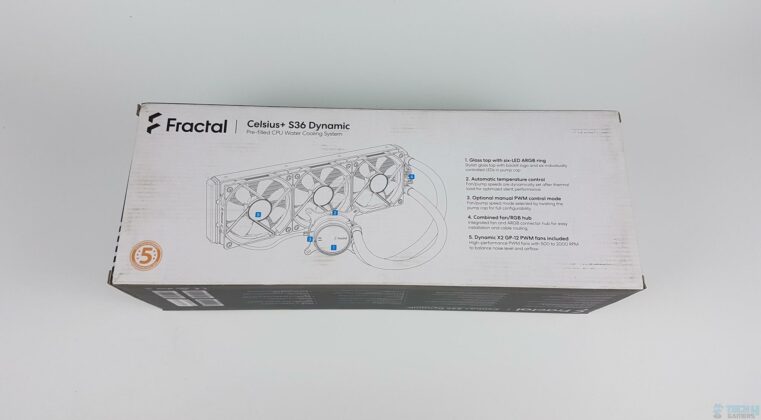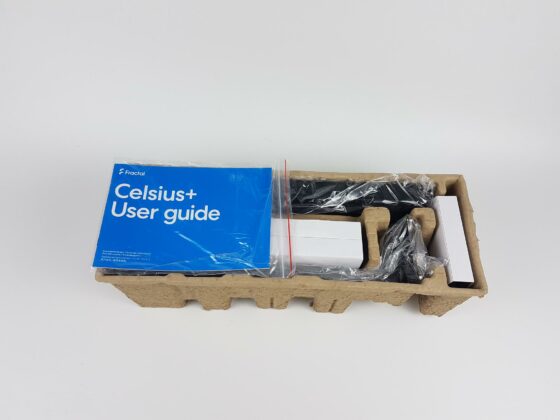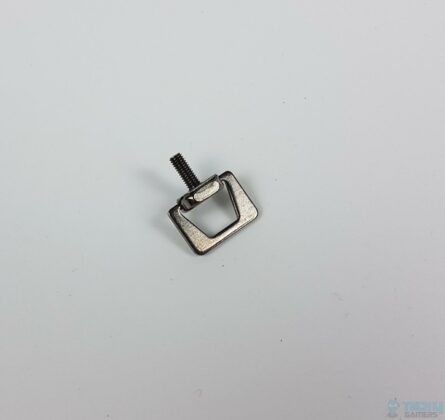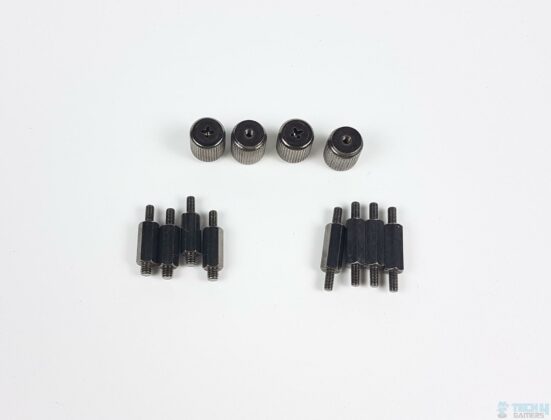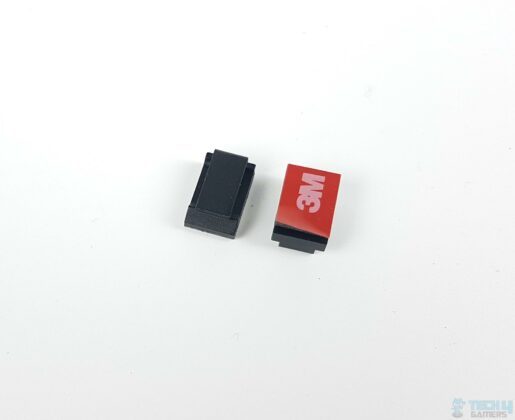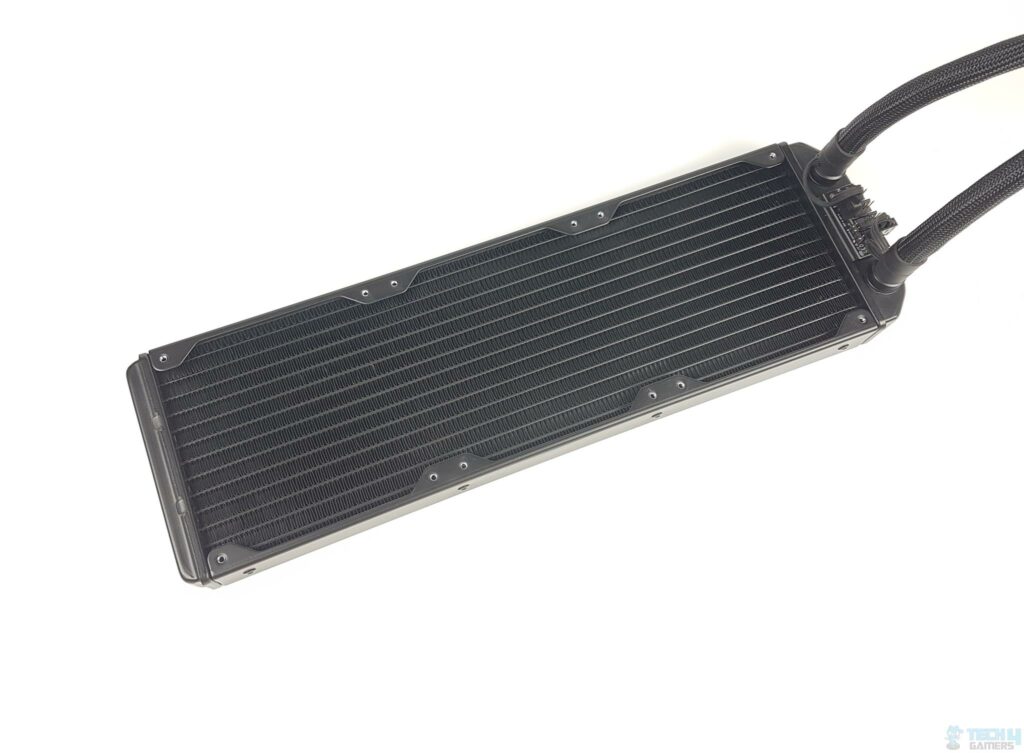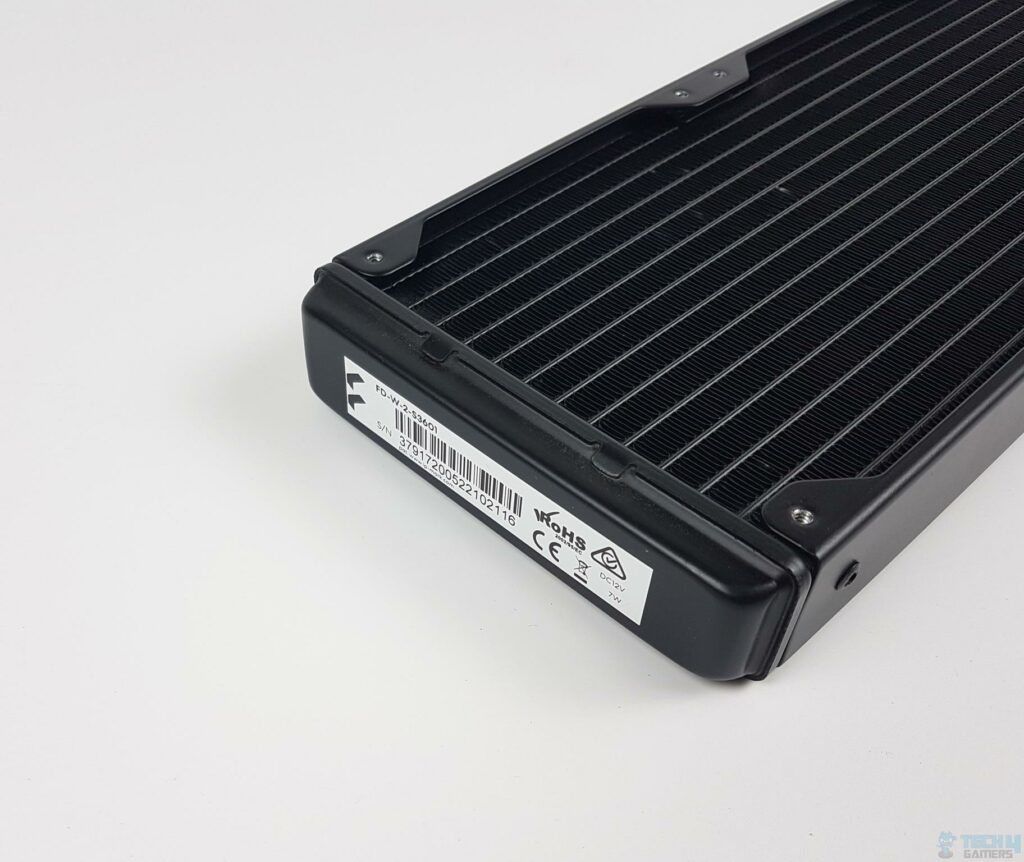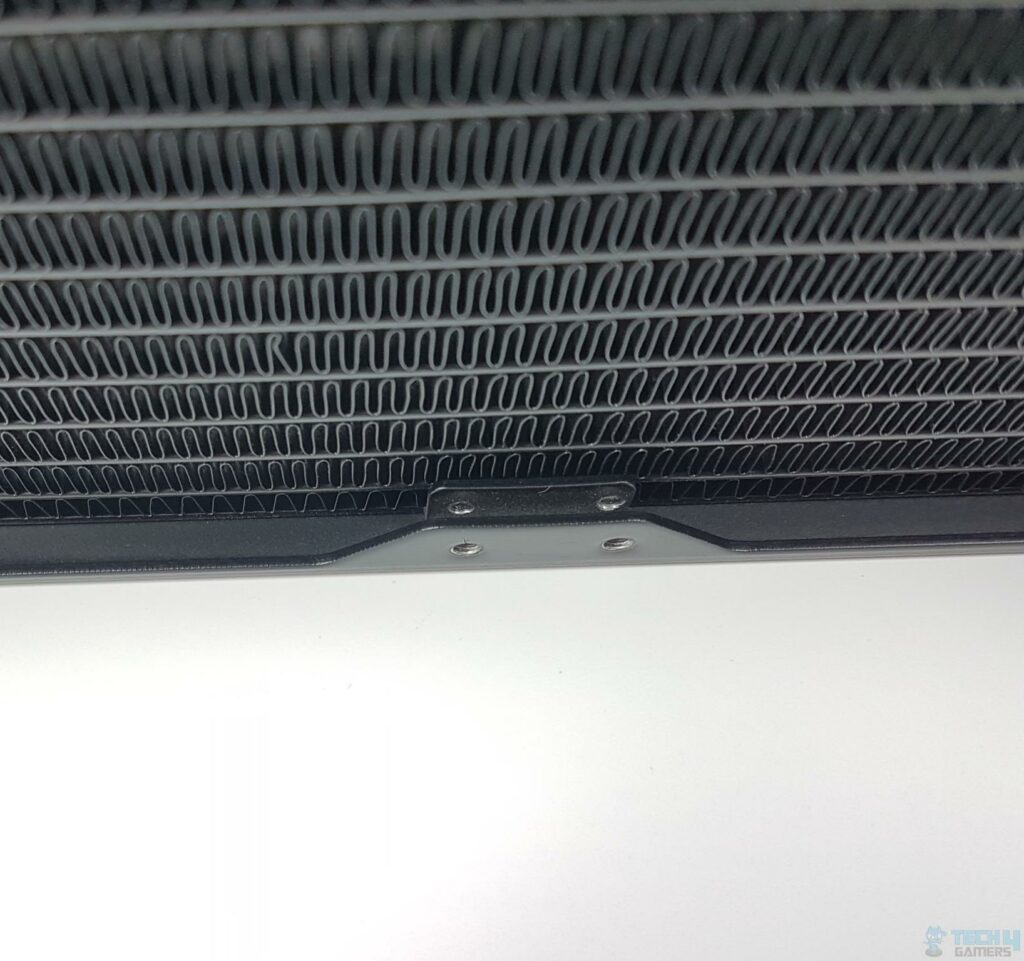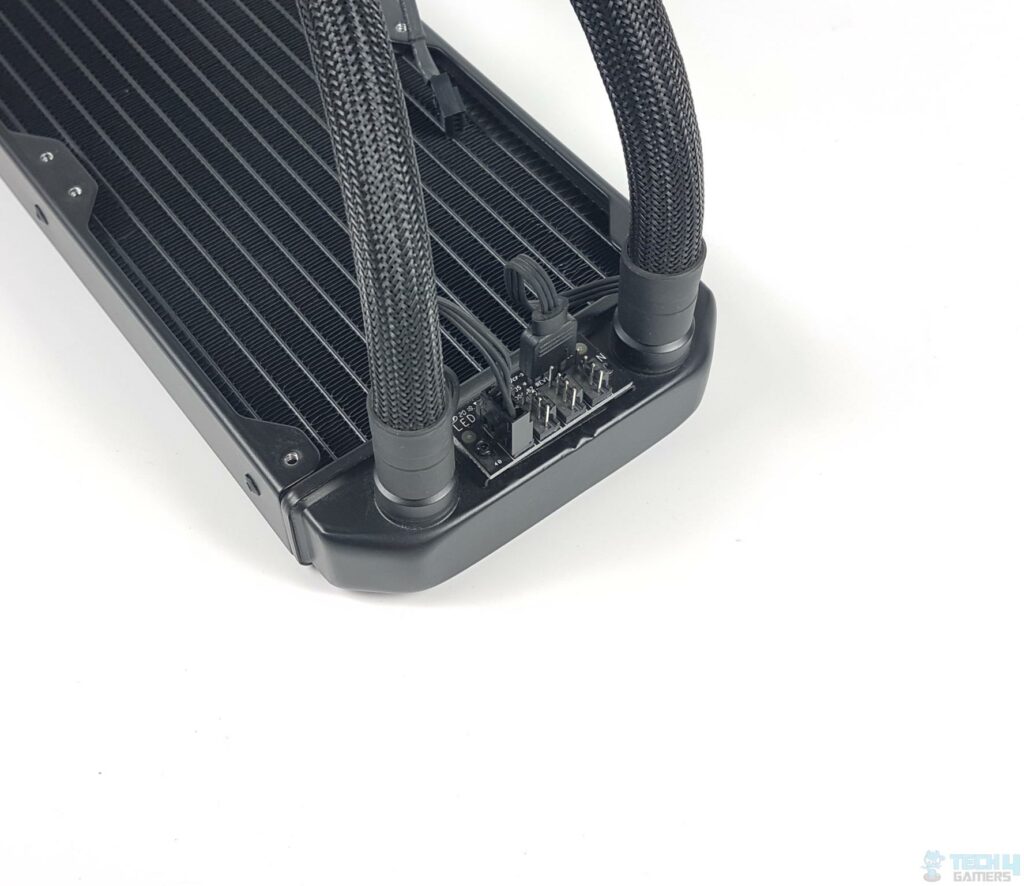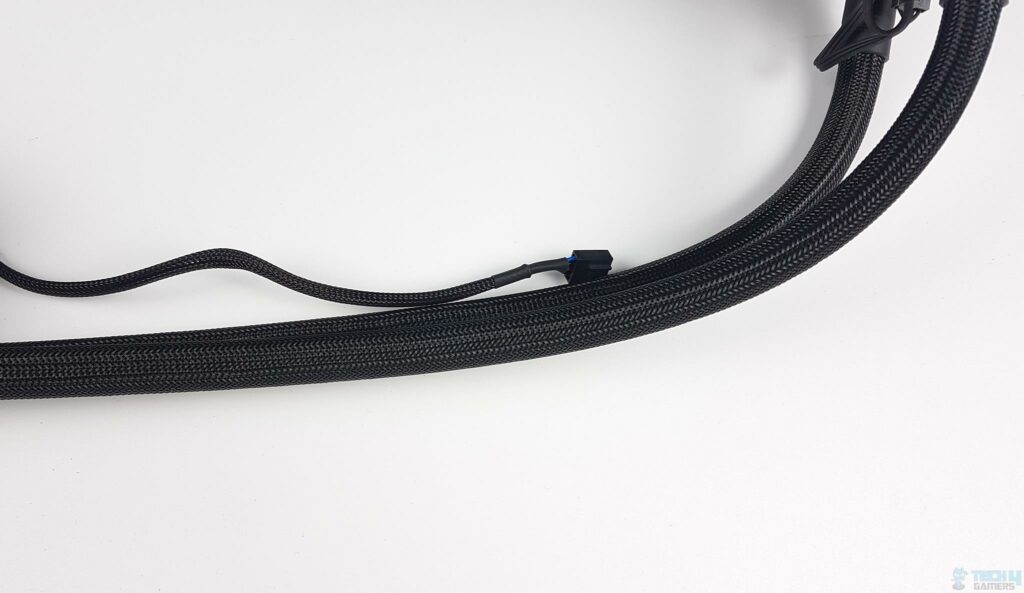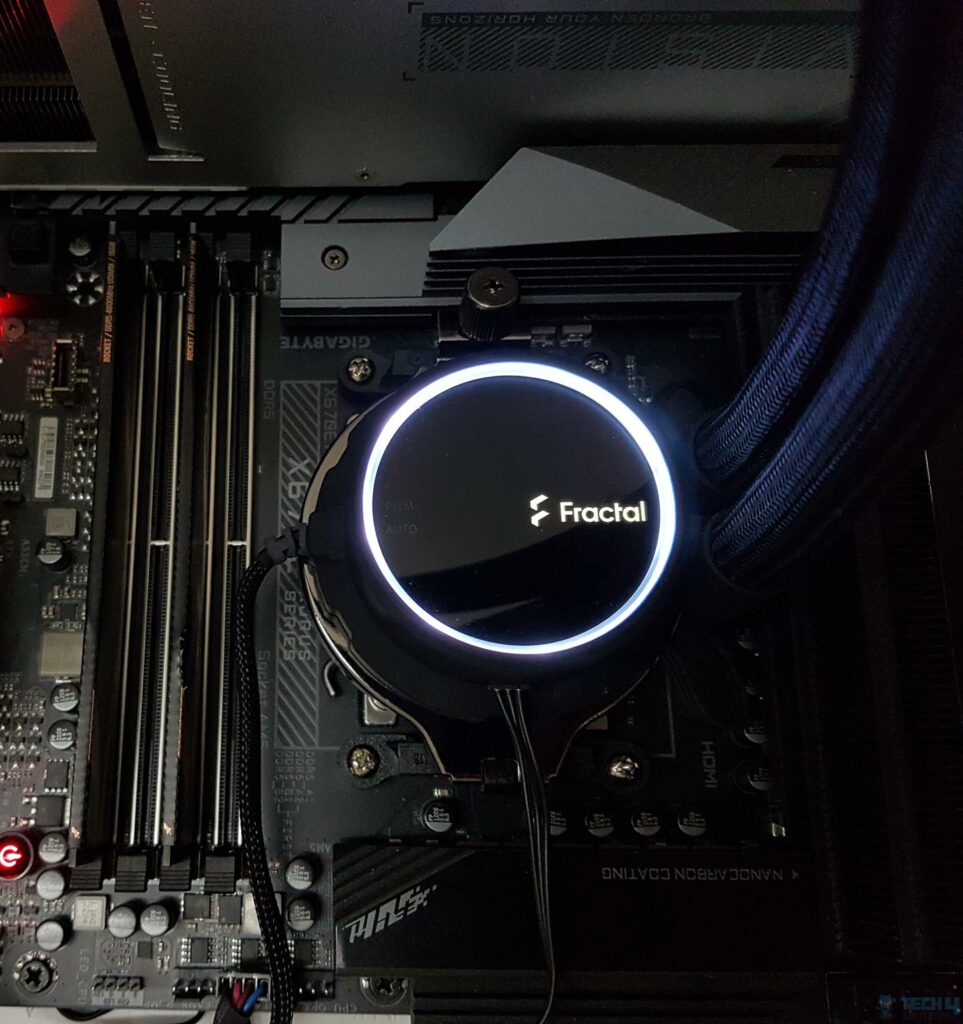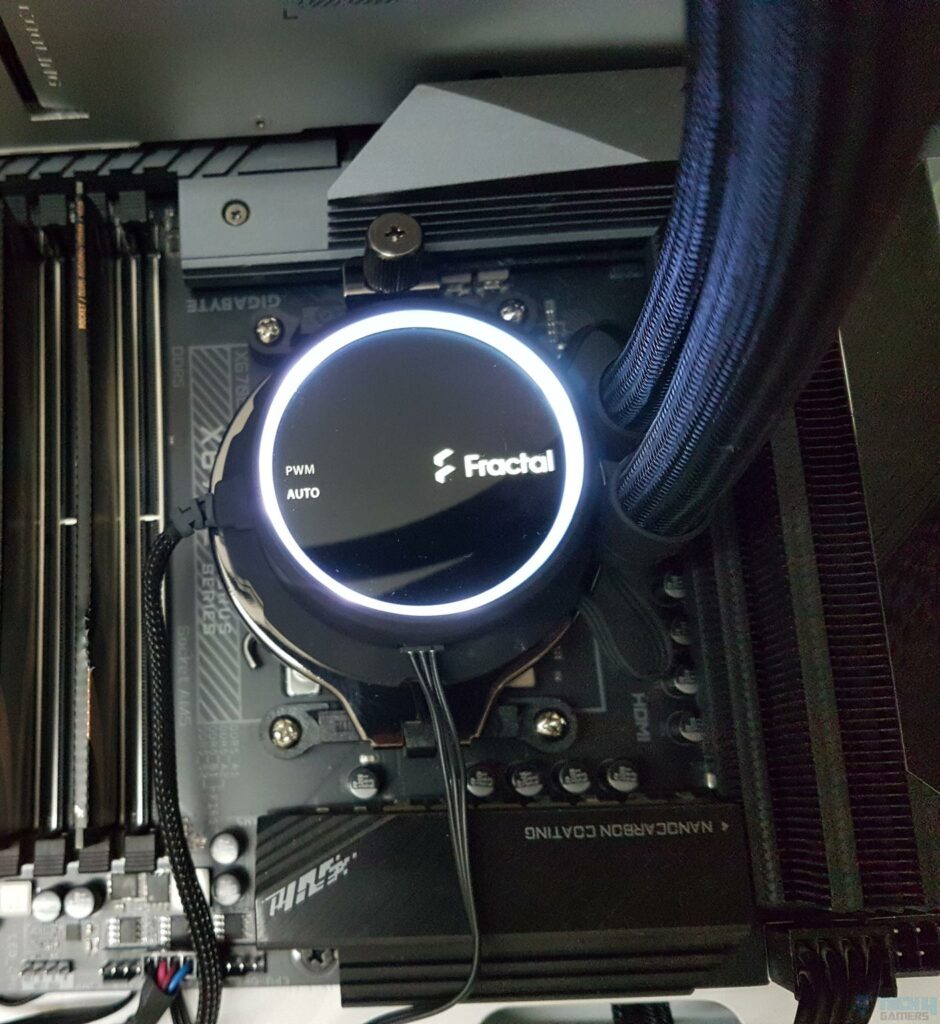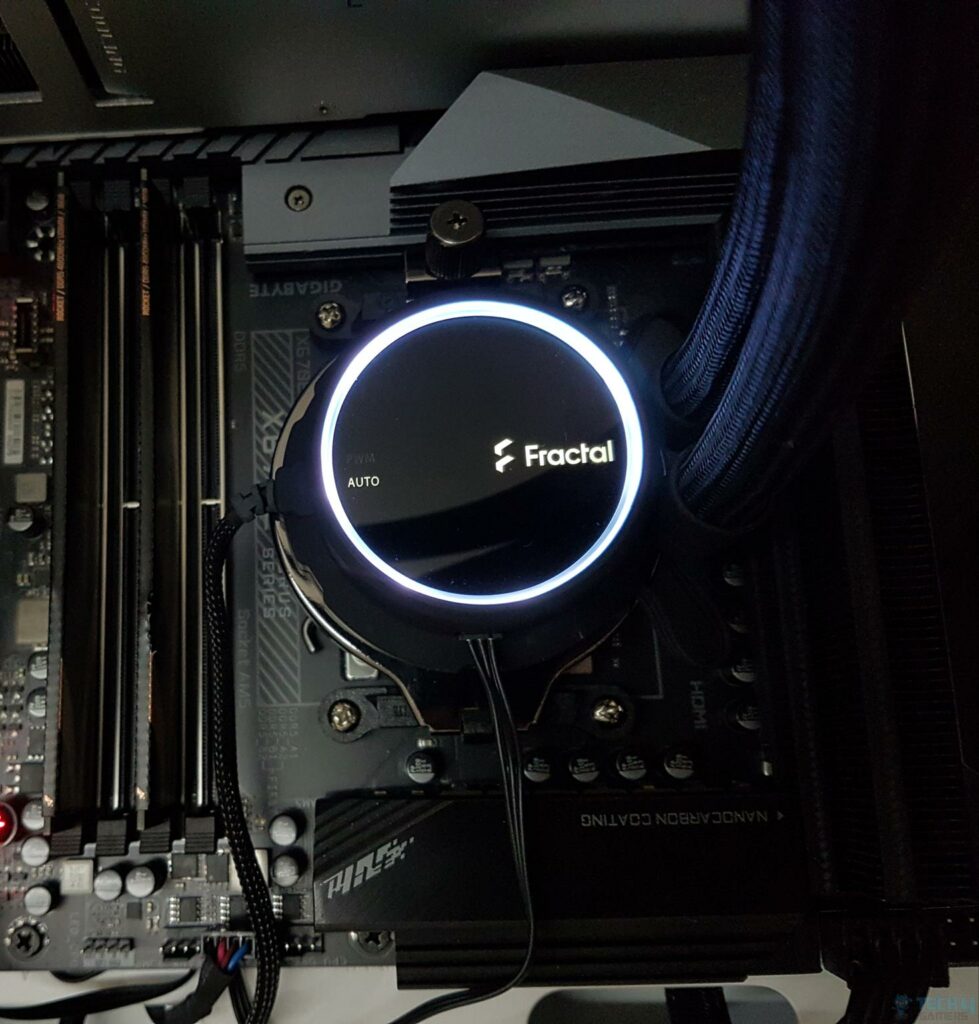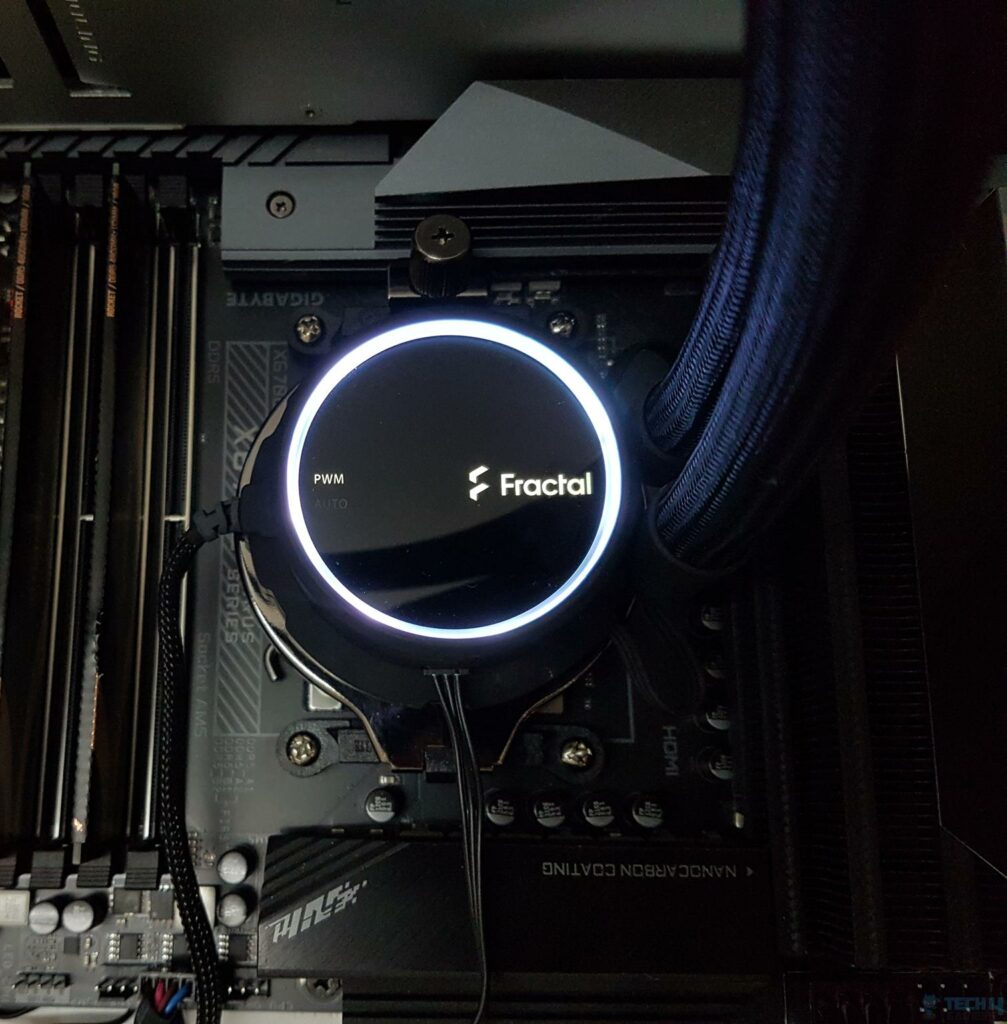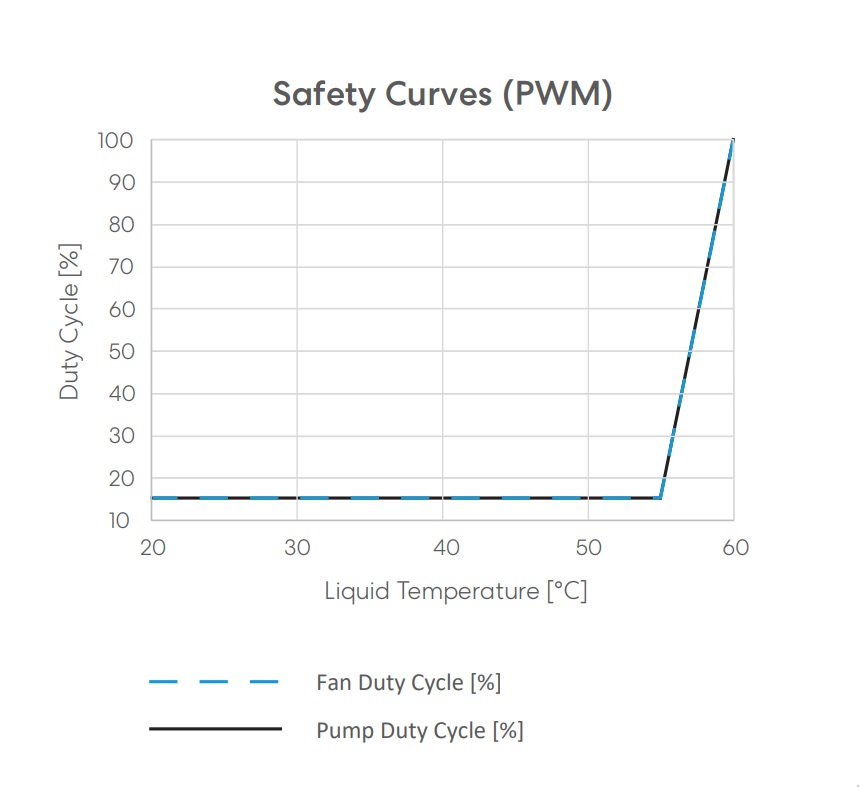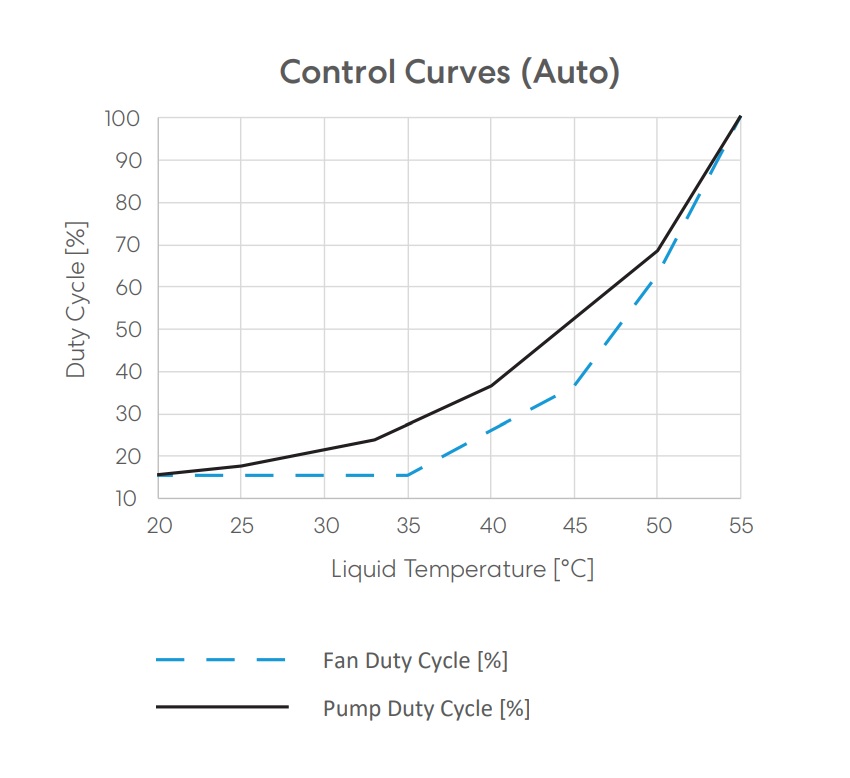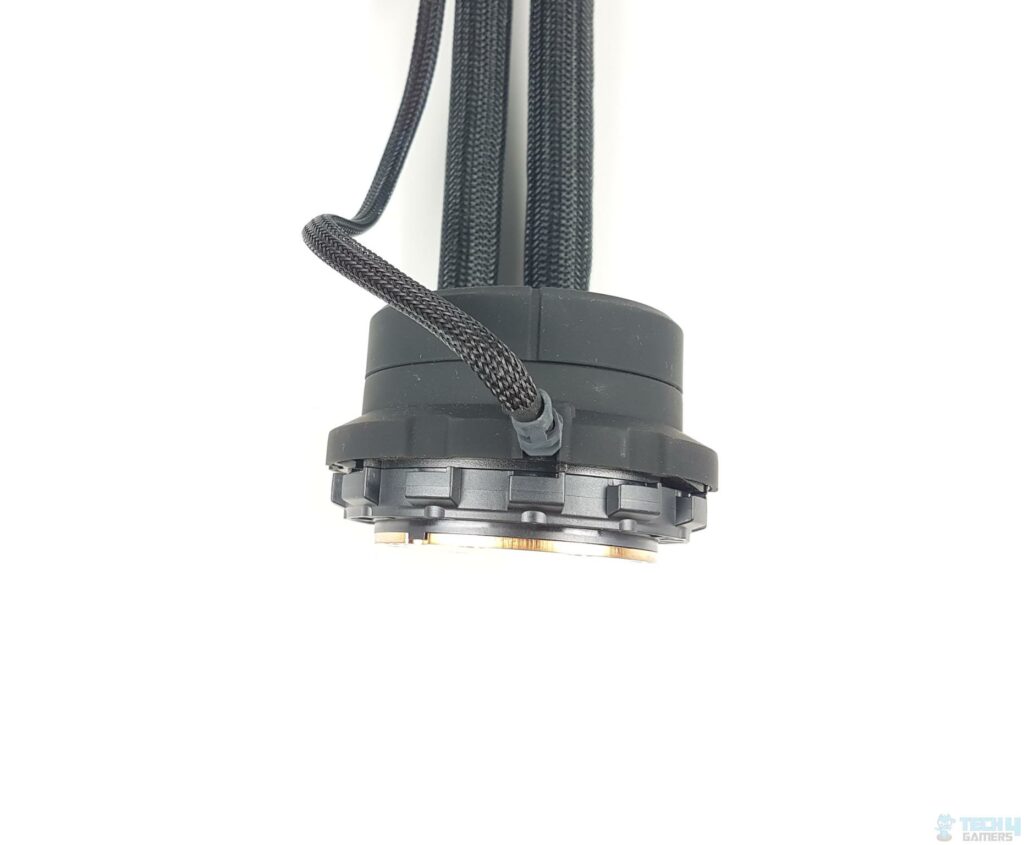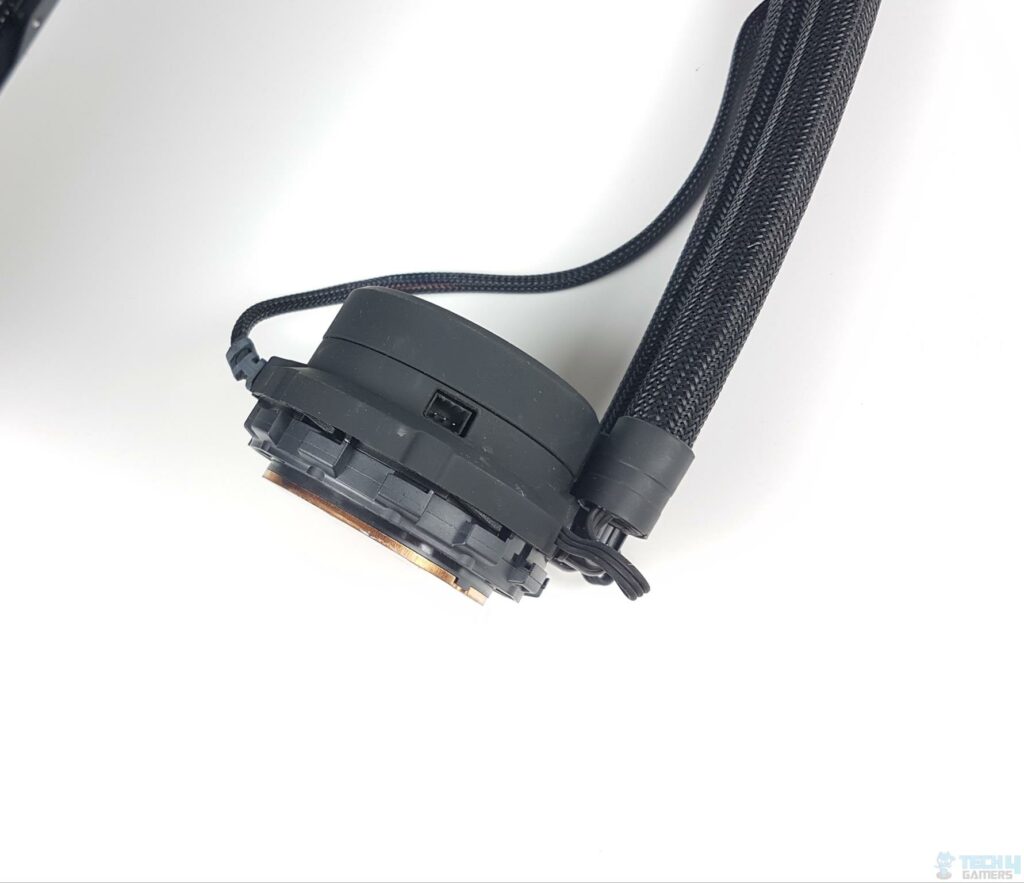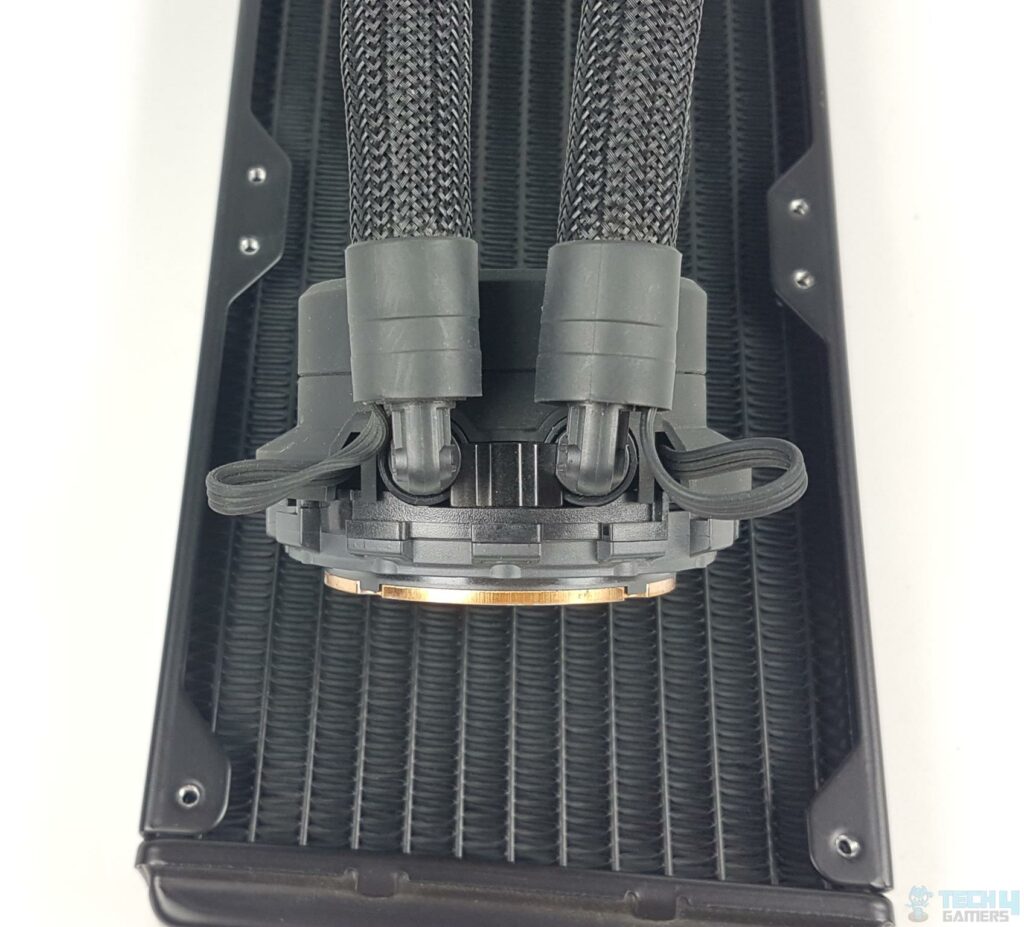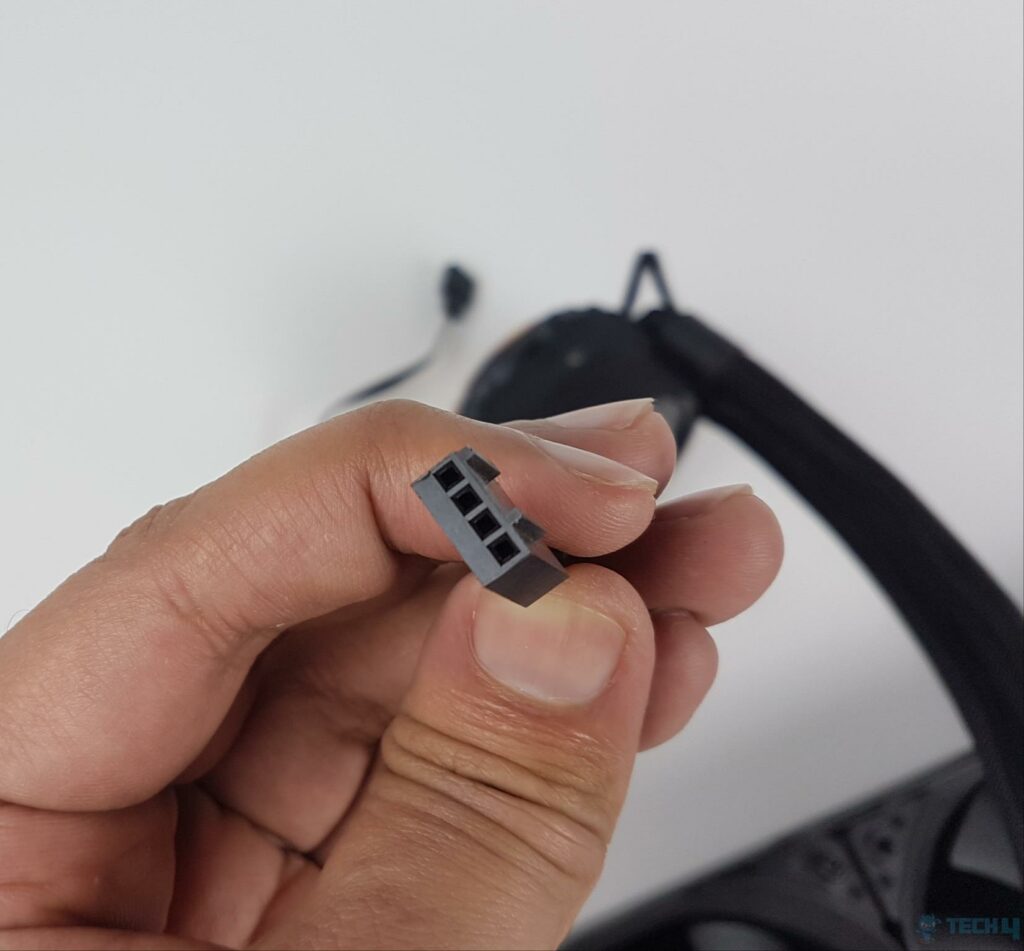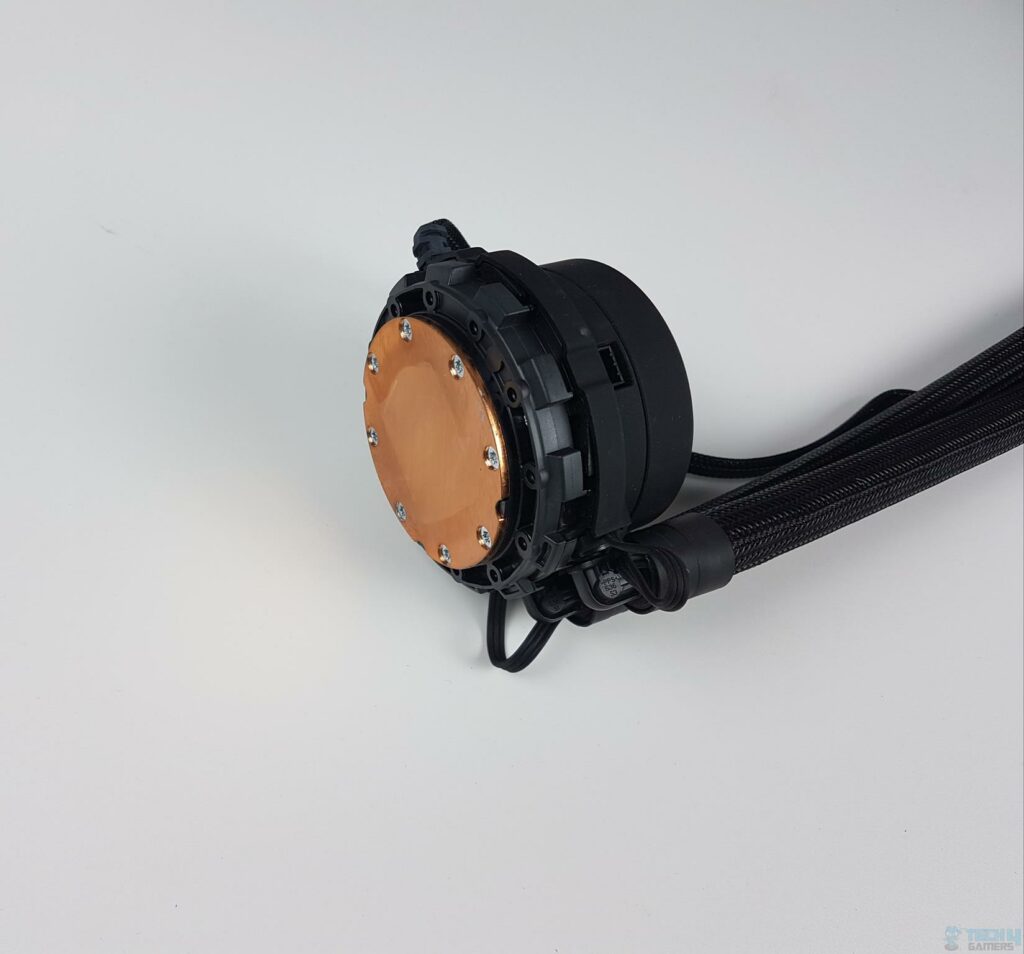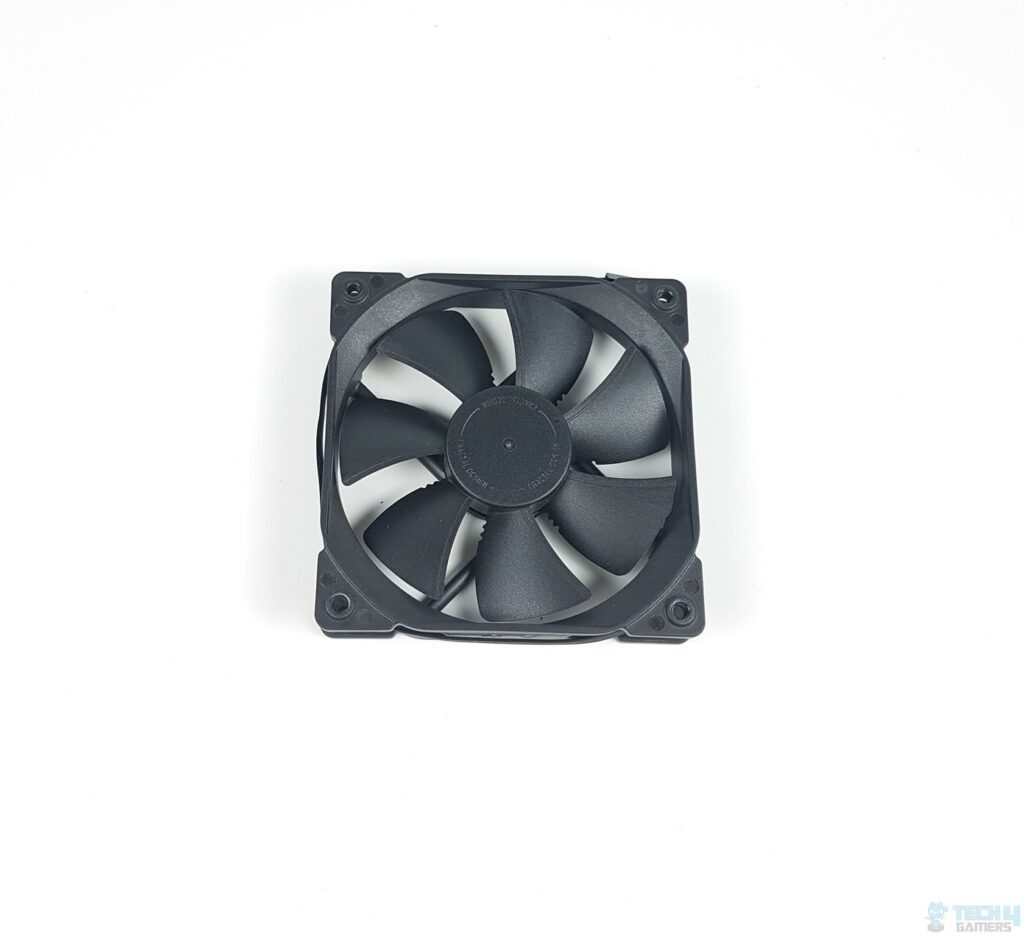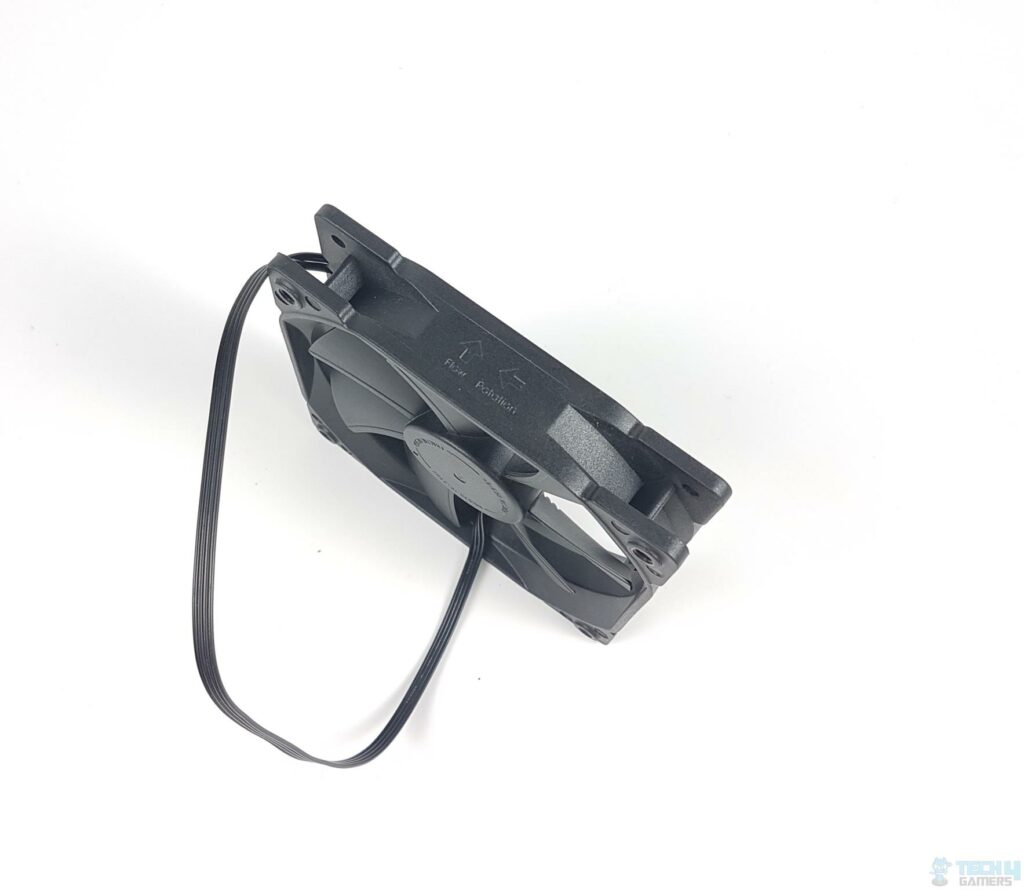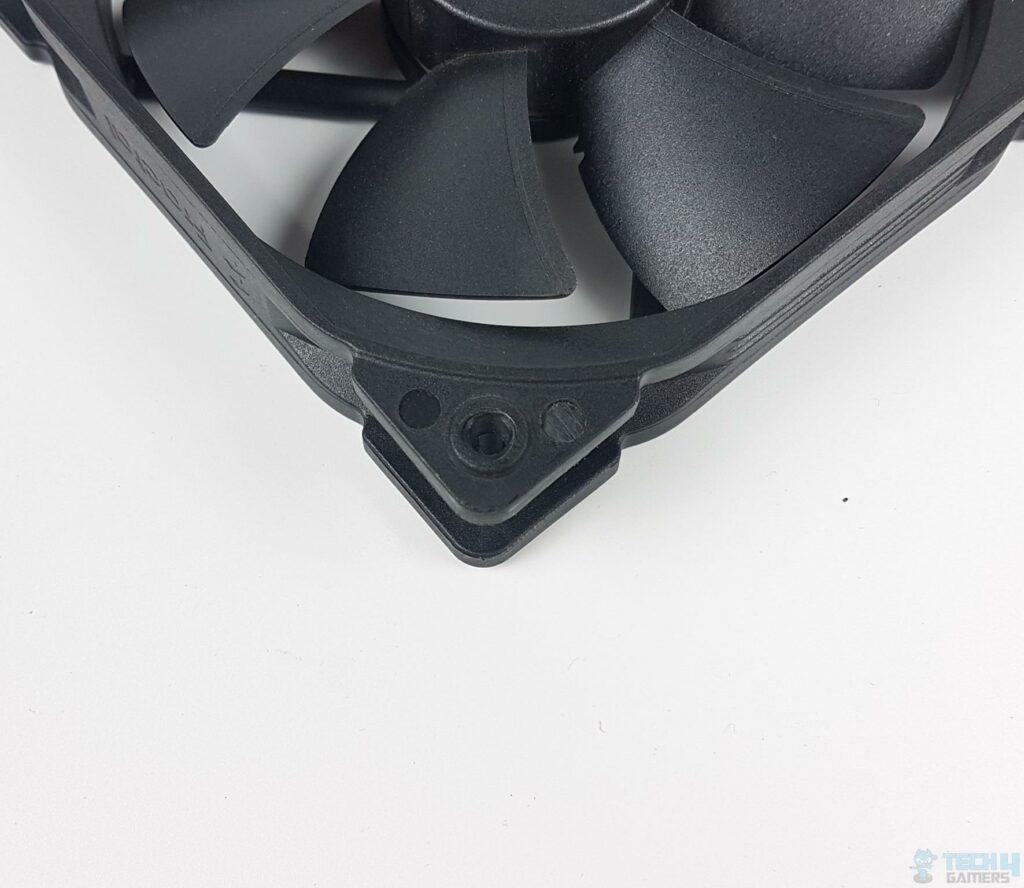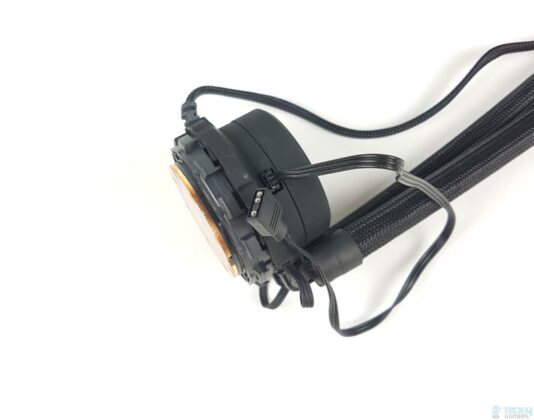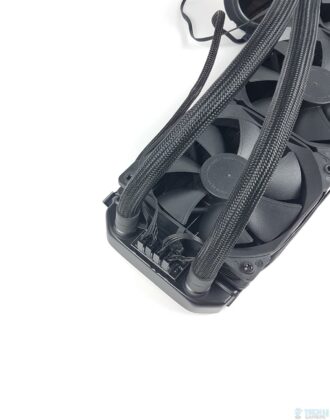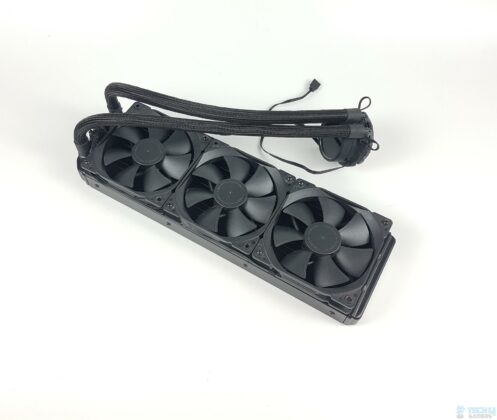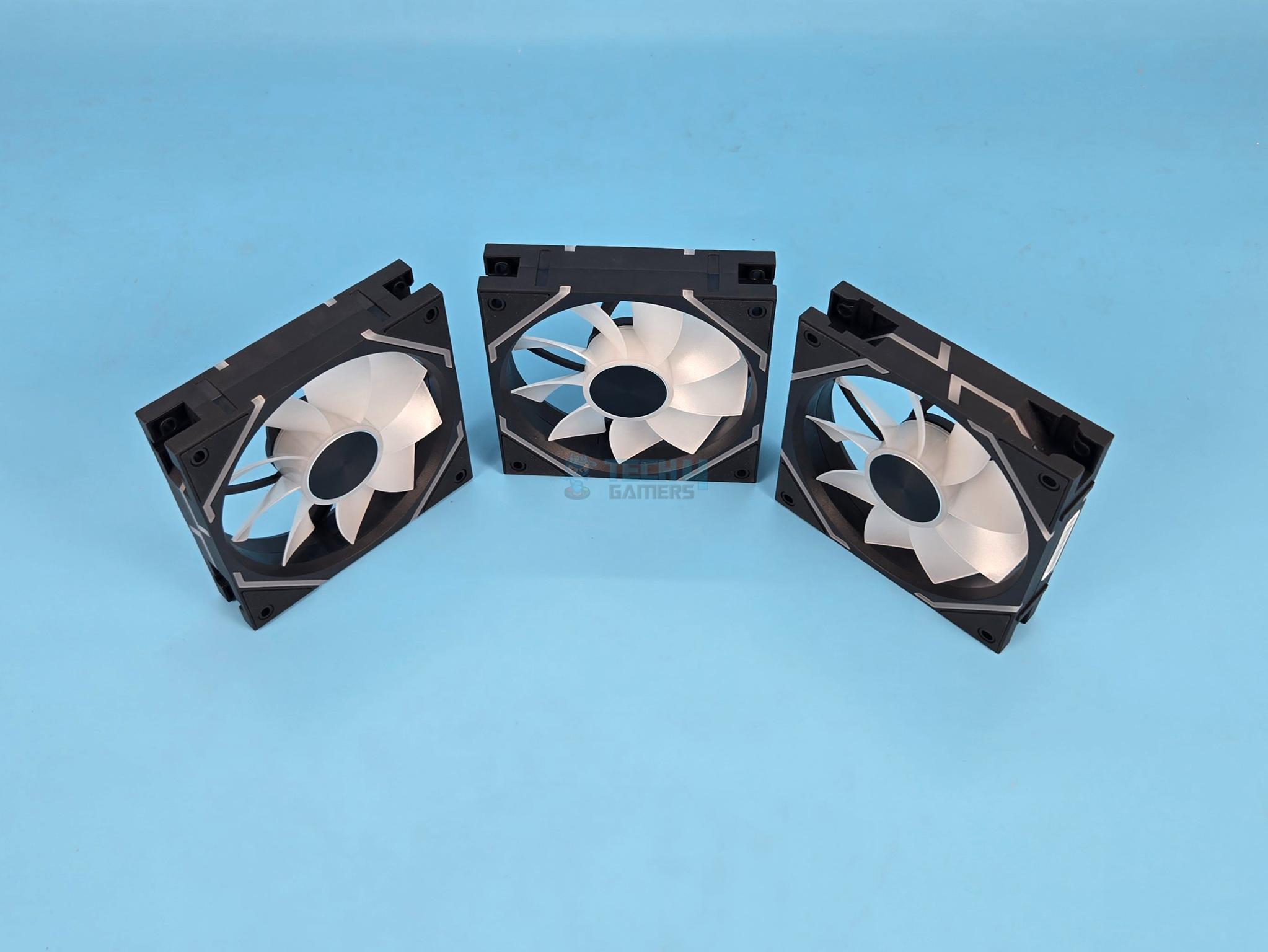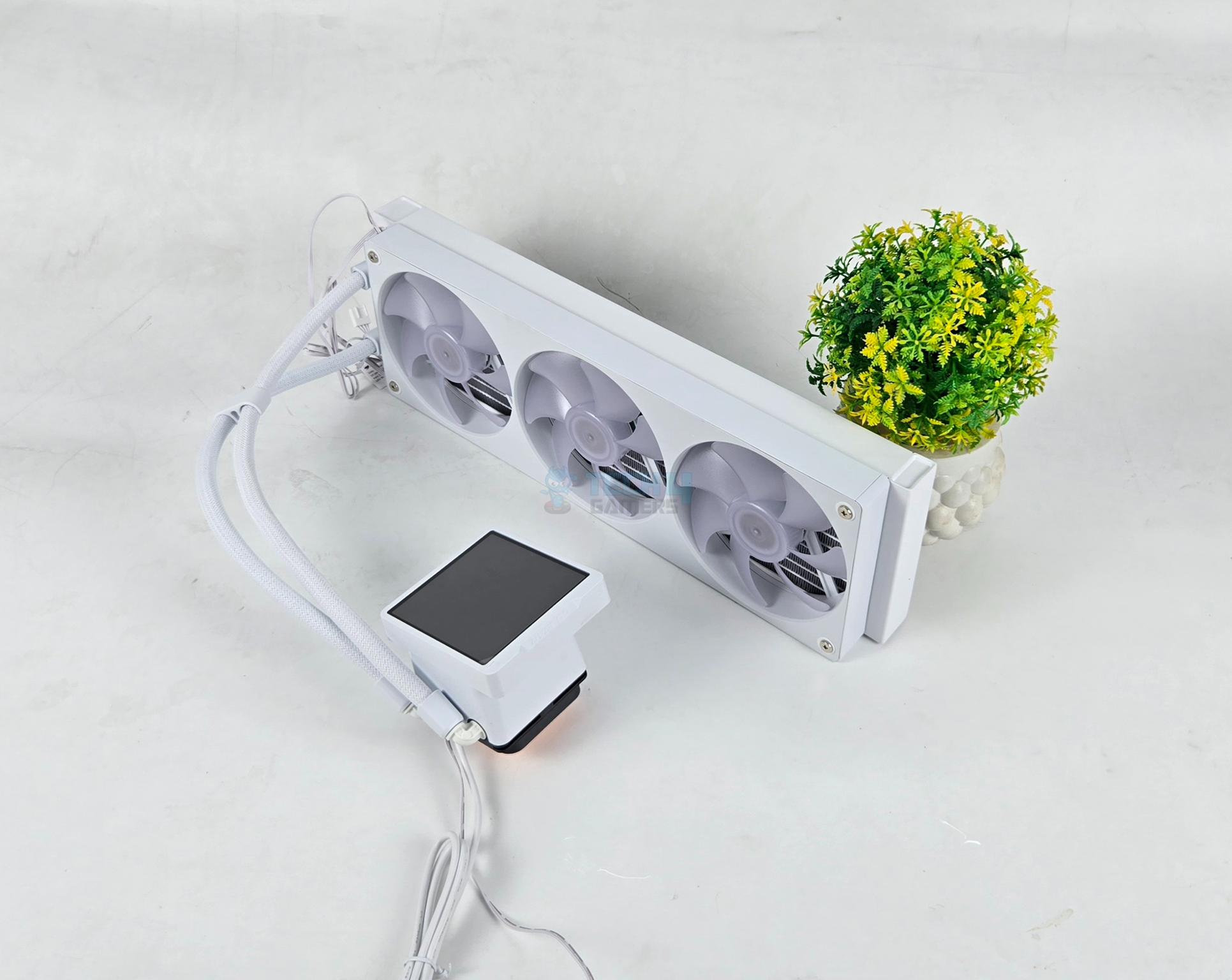Is It Still Good?
Review Summary
Fractal Design Celsius+ S36 Dynamic is still potent even on today’s platforms. This is a feature-rich cooling solution from Fractal Design using Asetek design. I would say it is a kick-ass cooler that offers a nice blend of features, an extended warranty, and good thermal performance, and it can still hold its ground.
Hours Tested: 5

Overall
-
Build Quality - 9.5/10
9.5/10
-
Design - 9.5/10
9.5/10
-
Performance - 9/10
9/10
-
Features - 9/10
9/10
-
Value - 8.5/10
8.5/10
Pros
- Good Performance
- Tinted glass pump face
- Flick Switch to change the thermal mode
- Digital RGB Lighting on the pump’s top plate
- Integrated Fan Hub
- Easy Cable Management
- Integrated coolant’s temperature sensor
- Single Cable Connection with a motherboard
- AMD AM5 socket support
- TR4 socket support
- Easy Installation
- Warranty
Cons
- Loud Fans at full speed
- Auto Mode loses full cooling potential in favor of silent operations
- Not compatible with Intel LGA1700
- Price
In focus today is the Fractal Design Celsius+ S36 Dynamic liquid cooler. Despite its lengthy name, it’s more concise than some competitors. Built on Asetek’s 6th-gen pump design, it offers RGB options, but we’re exploring the non-RGB variant.
Noteworthy features include an ARGB-accented pump face and an integrated fan hub on the radiator, reminiscent of ARCTIC Liquid Freezer – II. The design simplifies control with a single cable managing fans and digital RGB elements through the radiator’s fan hub, coupled with a 4-pin PWM cable from the pump housing.
Compatible with Intel and AMD sockets, including AM4 and TR4 (with limited block coverage), this cooler showcases Fractal Design’s commitment to innovation.
Key Takeaways
- Fractal Design Celsius+ S36 Dynamic liquid cooler impresses with its innovative design, featuring Asetek’s 6th-gen pump.
- PC enthusiasts seeking a liquid cooler with an innovative design should consider buying it because of its efficient cooling.
- Users seeking a more customizable RGB setup or enthusiasts prioritizing advanced control features over streamlined design should avoid this cooler.
- Why you can trust Tech4Gamers: Our reviews are based on dedicated hands-on testing by our team of experienced hardware experts. Find out more about how we test.
Let’s kick off this review and look at the cooler’s specifications:
| Product | Fractal Design Celsius+ S36 Dynamic Cooler |
|---|---|
| Supported sockets (Intel) | 1150, 1151, 1155, 1156, 1366, 2011, 2011-3, 2066 |
| Supported sockets (AMD) | AM2, AM2+, AM3, AM3+, AM4, FM1, FM2, FM2+, TR4 (via included bracket in AMD Threadripper box) |
| Coldplate material | Copper |
| Thermal paste | Pre-applied |
| Block height | 45 mm |
| Block measurements (with fittings) | 86 x 75 mm |
| Block diameter (main block body) | 62 mm |
| Pump rotational speed | 800-2800 RPM in normal use, 3500 RPM during thermal protection mode that activates if the liquid temperature is over 60°C |
| Pump bearing type | Ceramic bearing and shaft |
| Pump PWM control | Yes |
| Pump acoustical noise (full speed) | 20 dBA |
| Pump maximum pressure, 50°C | 1.46 mm H2O |
| Pump input voltage | 12V DC |
| Pump input current (without fans) | 0.36A |
| Pump MTTF | 50,000 hours |
| Tube length | 400 mm |
| Tube material | Low-permeability rubber with braided nylon sleeve |
| Fittings, block side | Articulating 90-degree elbow |
| Fittings, radiator side | Straight rotary |
| Fan control | Dual mode (Auto/PWM) |
| Warranty | 5 years |
| Fan type | Dynamic X2 GP-12 PWM |
| Rotational speed | 500 – 2000 RPM |
| Bearing | LLS |
| PWM | Yes |
| Acoustic noise (max) | 32.2 dBA |
| Airflow (max) | 87.6 CFM |
| Static pressure (max) | 2.3 mm H2O |
| Input voltage | 12V DC |
| Input current (max) | 0.2A |
| MTBF | 100,000 hours |
| Radiator dimensions | 123 x 30 x 403 mm |
| Radiator housing material | Aluminum |
| Radiator fin material | Aluminum |
| Radiator fan screw threads | 6-32 |
Packaging Box
Box Contents
It is time to take a look at mounting hardware.
Design
Let’s look at this cooler’s design.
Radiator
This cooler is entirely made of aluminum material, including its housing. This is a standard design for AIOs. This unit has a dimension of 403 x 123 x 30mm. As usual, our focus is on the thickness, which is 30mm. Adding a 25mm thick fan over would give an overall height of 56mm, including heads of screws.
This is a dense fin stack, and Fractal Design has done well here. The FPI count is 20, so high static pressure fans would be needed. There is a distance of 105mm between any two mounting holes on opposite sides. There is a gap of 15mm between two adjacent mounting holes on a side.
This radiator has 12 channels for coolant flow. Fractal Design has used 6032 threading on mounting holes. Both blocks of this radiator are rounded on corners and have a slim outlook. We have mentioned that this is Asetek’s design based on their 6th generation.
We can see a serial number sticker and a power rating, which is probably of the pump unit. It is 7W using 12VDC.
Each side of the radiator has a protective frame that seems to be riveted. There is no branding of any sort on either of these sides. Unlike most AIOs in the market, this cooler has protective plating right below the mounting holes. This is there to prevent any damage to fins from excessive screwing.
I’ve been hands-on with this Fractal design, and I must say, the planning and execution are top-notch. The radiator boasts straight rotary fittings and substantial couplings, which might add a bit to the thickness.
The 4-port PWM and 2-port digital RGB lighting hub, seamlessly integrated on a sleek black PCB, grabbed my attention. It offers 2 digital RGB headers and 4 PWM headers. Remember, though, that you’ve got one RGB and three PWM slots free due to pre-routed cables occupying some ports.
The labeled PCB helps nail the connections, making fan and RGB setups a breeze. Fractal Design has used a low-permeability rubber tube on this cooler. These tubes have a length of approximately 400mm.
They have a nylon braiding sleeve, which also hides two flat cables. One cable is routed under one tube. This is another well-thought-out execution.
Pump Housing
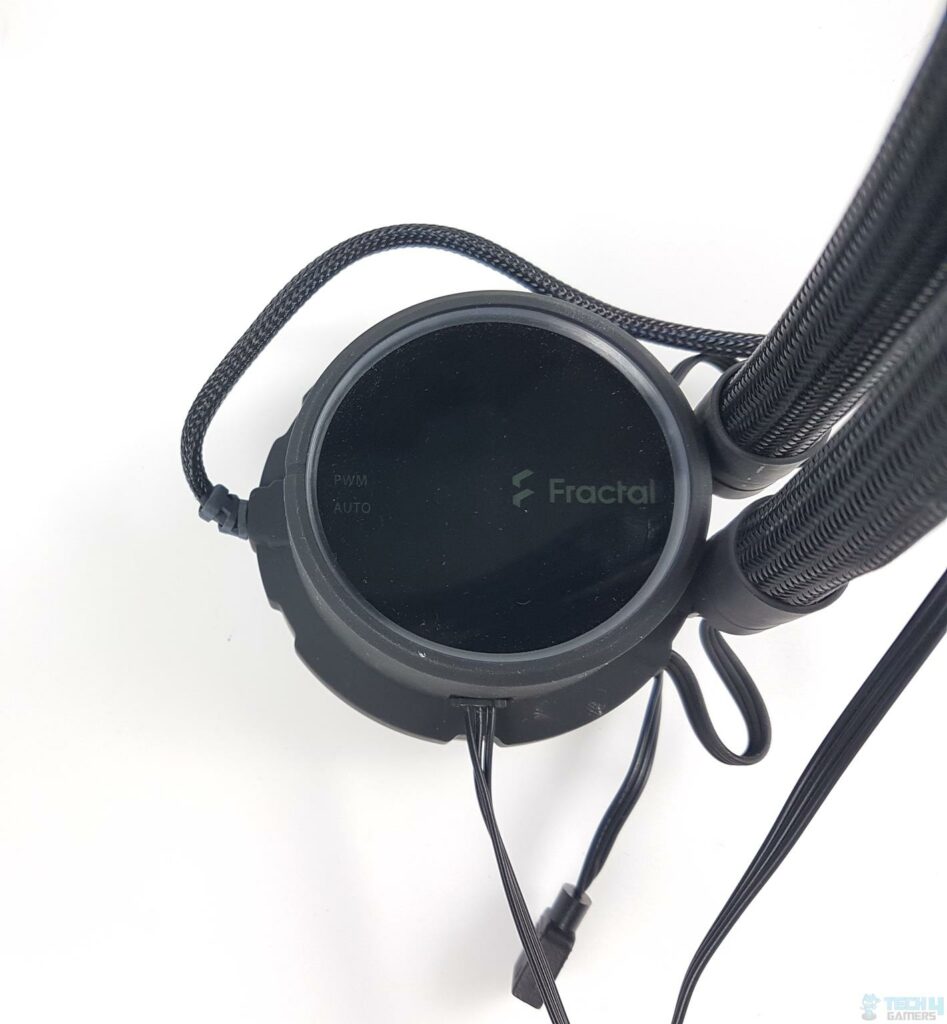
Let’s look at the pump housing and see what magic Fractal Design has done here regarding customization on top of the Asetek pump. This is a low-profile design standing at 86x75x45mm with fittings. It is circular and made of ABS material. The main body has a diameter of 62mm.
There is a tinted glass pump face over the top. It has a backlit Fractal Design logo and a digital RGB ring using 6x LEDs. We can also see Auto and PWM text there as well. The top frame acts like a switch. It can be rotated to switch from Auto to PWM and vice versa.
This will change the profiles of the fans and pump. These texts are white color backlit. We can spot a diffuser running on the border up top. It is not in a white frosted like many other solutions carry.
The above picture shows white color backlighting on Fractal text. White color lighting is on the ring as well. Auto and PWM text remain backlit when the switch is activated for a few seconds. This shot was taken during this time. Sorry for the poor quality.
Here, we are activating the auto function, which will immediately stop the loud noise from fans. Here, we are activating the PWM function, which is a default function. This mode will keep fans and pumps running at full speed.
Since we are at it, let’s briefly see what each mode does. In a standard configuration, users are expected to connect all three fans to the integrated fan hub, and only one cable would be connected to a motherboard’s fan header. That cable is coming from the pump’s housing.
Fractal Design prioritizes silent operations in Auto mode with predefined fan curves. Switching modes is done through a physical switch on the housing, ensuring the pump noise stays at or below fan noise (20 dB[A]).
While it minimizes noise, it limits fan performance and increases coolant temperature. In PWM mode, control is through the motherboard, but fans and pumps operate synchronously, restricting independent speed control.
To control them separately, fans must be connected directly to the motherboard, sacrificing hub functionality and increasing overall cost.
Looking at the front side of the housing, we can see a well-sleeved cable coming out from here. This is a 4-pin PWM cable that connects the pump to the power source. Flat cables make cable management and concealment easier.
There is a 3-pin header on the side of the housing. The provided digital RGB cable is to be connected to this port. This angle better shows a design. There is a line between the top and base portion, segregating both so that the top can be switched.
The other or opposite side of the housing has a plain surface. The base below the main housing has latched. Anyone familiar with Asetek will immediately notice it. The mounting rings are attached to these catchers.
Fractal Design has implemented articulating 90° elbow fittings on the pump’s housing. This would reduce tension on the pump and make the rotation of tubes easier. Overall build quality is top-notch. We can see two cables coming from both tubes and inside the housing. This is a smart design. The cable has a 4-pin PWM connector.
The Fractal Design Celsius+ S36 Dynamic is based on Asetek’s 6th generation pump.
Cooler Fans
It seems like this unit has a sensor to monitor the coolant’s temperature; otherwise, there is no way for it to know if the temperature has crossed 60°C to engage 3500 RPM mode.
This cooler comes with a pre-applied thermal paste, another Asetek design feature. We wiped that paste to take this picture.
Fractal Design has provided 3x X2 GP-12 PWM Dynamic fans. These are non-RGB versions. They are high-performance editions. Each fan has 7x blades in black color. Each blade has notches to diffuse noise from blade/stator interaction, as mentioned by Fractal Design. There is no branded sticker on the center.
One side of the frame has two arrow symbols. These help the user identify the airflow direction and the blades’ spin direction. These are clearly labeled as well. Each mounting corner has a circular-shaped thin layered anti-vibration pad.
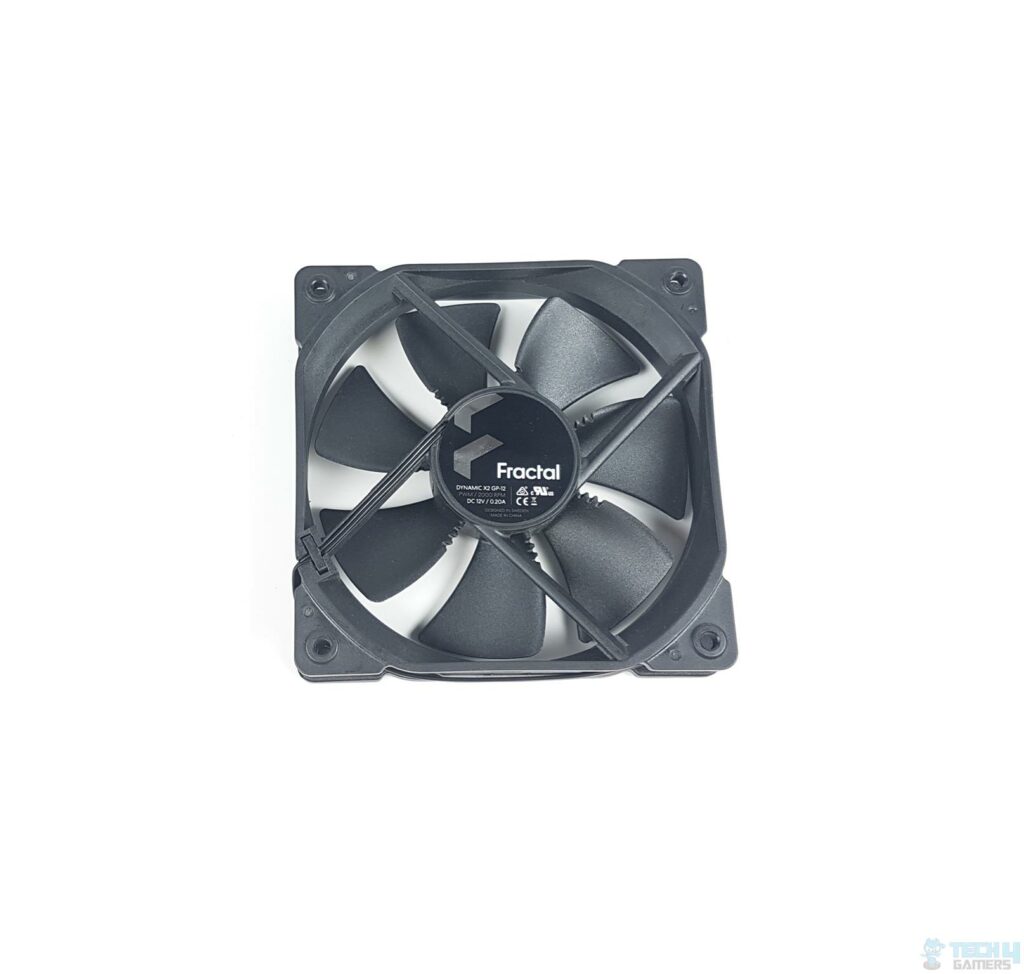
The backside of the fan shows the 4-arms assembly. One arm catches the wires coming from the center. This side of the fan has a Fractal Design branded sticker.
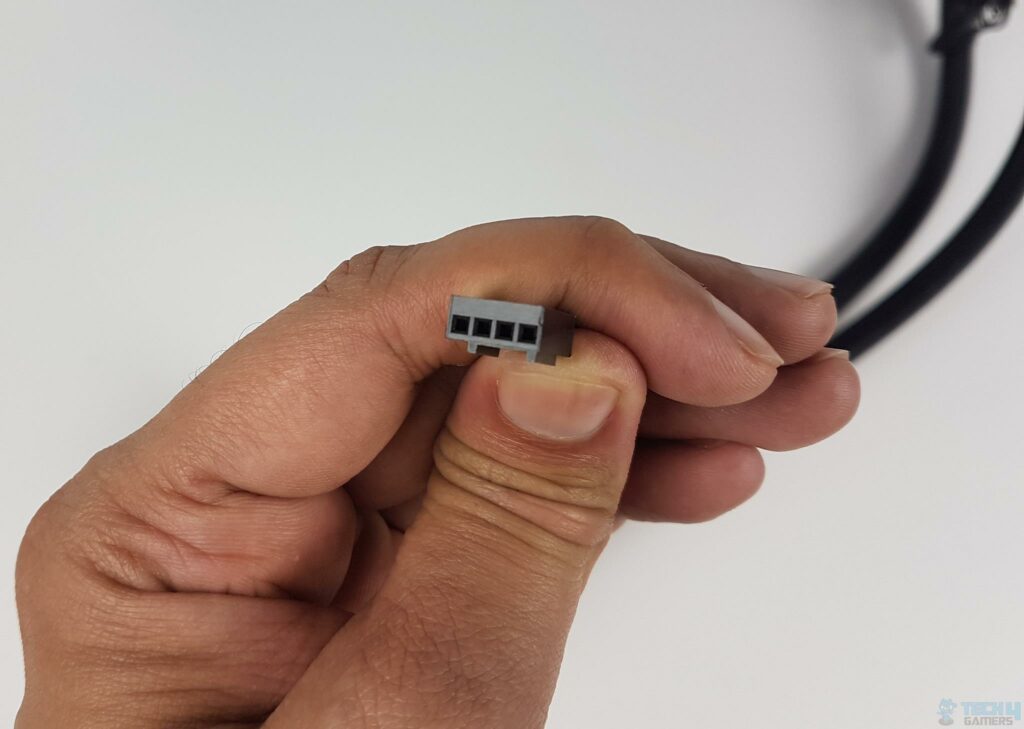
Each fan has a 4-pin PWM connector on a flat cable.
Fan’s specifications include:
| Dimension | 120x120x25mm |
| Type | 4-pin PWM Connector |
| Speed | 500-2000 RPM |
| Airflow | 87.6 CFM |
| Air Pressure | 2.3 mmH₂O |
| Noise | 32.2 dB(A) |
| Bearing Type | LLS |
| Lifespan | 100000 hours |
| Input Voltage | 12VDC |
| Input Current | 0.20A |
Installation
We tested the cooler on AMD AM5 with GIGABYTE X670E AORUS MASTER and AMD Ryzen 7 7700X.
Installation on AM5 is straightforward using the clip method. The AMD ring has a catcher on one side; prepare the other, pass a clip through the mounting ring’s armhole, and secure with a thumbnut.
Keep it loose, press on the stock brackets, clean the CPU surface, and carefully place the block. Apply pressure, snug the clip on the other bracket’s catcher, and torque the thumb nuts. Cooler installed.
Clearance
This cooler has a dimension of 403x120x30mm without fans. With a fan, this size is 403x123x56mm. This cooler has thicker tube endings, which could obstruct the first DIMM slot. Other than that, there is no clearance issue. You must check that your PC Case has clearance for this size radiator. 403mm is a bit longer, probably due to the integrated fan hub.
Thermal Test
We have used below mentioned configuration to test the performance of this cooler: –
- AMD Ryzen 7 7700X
- GIGABYTE X670E AORUS MASTER
- XPG Lancer RGB 2x16GB @ 6000MHz
- GIGABYTE GeForce RTX 3060 VISION OC Rev.2 [For Display]
- Sabrent Rocket 4 Plus 2TB NVMe SSD [For OS]
- be quiet! Straight Power 11 850W Platinum PSU
- Thermaltake Core P6 TG Snow Edition in an Open Frame Layout
Here is the settings table for testing:
| All Cores | 5200MHz All Cores |
| VCore (V) | Auto |
| Thermal Paste | Alphacool Sub-Zero |
| Test Run Time | 30 minutes CINEBENCH R23.2 |
| Idle Time | 10 minutes |
| Fan/Pump Speed | 100% PWM Duty Cycle |
| Monitoring Software | HWInfo64 |
This could be due to various reasons like thermal paste application, ambient temperature variation, the mounting pressure of the cooler, etc. This is very why we have listed our variables and their settings. Variables not mentioned are on the Auto setting.
Result
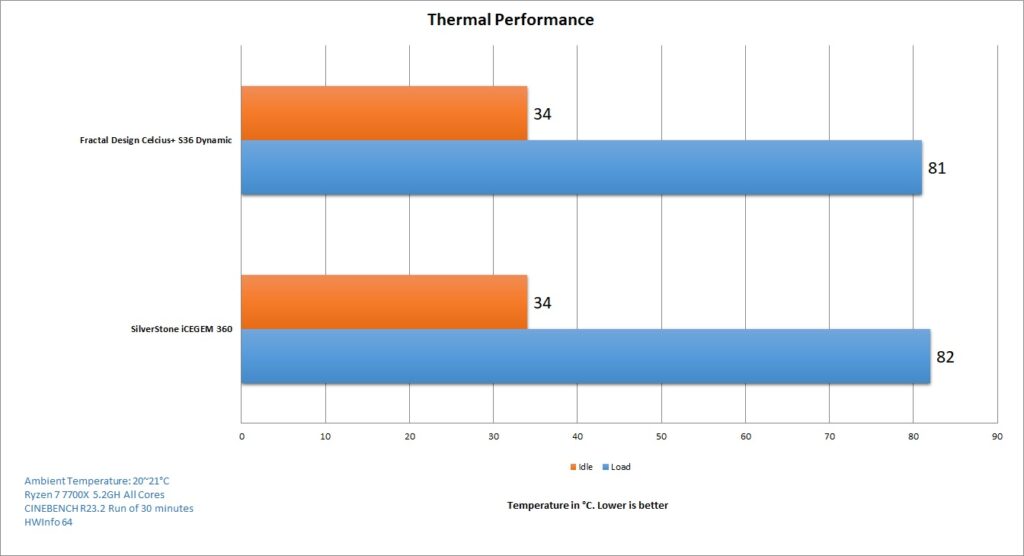
We are seeing a tight competition between two 360mm liquid coolers in the graph, with Fractal Design Celsius+ S36 Dynamic winning by only a 1°C difference.
Noise
We noted a noise output of roughly 55dB(A) on an ambient noise level of 32~33dB(A). The fans and pump were set to run at full speed via BIOS settings. A custom fan curve in this regard would be helpful.
Should You Buy It?
Buy It If:
✅ You demand silent Operation: If you prioritize a silent operation over maximum cooling potential, the Fractal Design Celsius+ S36 Dynamic is designed to run silently in Auto mode, keeping noise at or below 20 dB(A).
✅ You prefer RGB Lighting: For those who enjoy RGB lighting, the cooler is available in Digital RGB (PRISMA) editions, adding a vibrant visual element to your setup.
✅ You value Compatibility Across Platforms: If you have a diverse range of systems, the Celsius+ S36 Dynamic liquid cooler’s compatibility with various Intel and AMD sockets, including the latest AM5 and AM4, makes it a versatile choice.
Don’t Buy It If:
❌ You seek top performance: If you’re keen on maximizing cooling performance and prefer running the pump at its full speed, the limitations in PWM mode might not align with your preferences, as the pump operates at the same PWM duty cycle as the fans.
❌ You operate an Intel LGA1700: If your system utilizes the Intel LGA1700 socket, note that the Fractal Design Celsius+ S36 Dynamic is incompatible. Waiting for further clarification from Fractal Design is advisable.
❌ You are a Custom Fan Curve Enthusiast: If you want to customize the fan curve for optimal performance, the standard configuration in PWM mode may limit your ability to control the pump and fans independently.
Conclusion
Having hands-on experience with the Fractal Design Celsius+ S36 Dynamic liquid cooler, I’m genuinely impressed by the prowess of Asetek’s 6th-gen pump. The cooler offers versatility with both RGB (PRISMA) and non-RGB (Dynamic) options across various sizes (240mm, 280mm, 360mm).
Compatibility spans a range of Intel and AMD sockets, though, unfortunately, it excludes LGA1700. The aluminum radiator, boasting 12 coolant channels and a dense fin stack, is complemented by three Dynamic X GP-12 PWM fans, ensuring effective cooling.
The thoughtful design extends to details like low-permeability rubber tubes and an integrated fan hub, showcasing Fractal Design’s attention to detail. The pump housing, featuring a tinted glass face and a digital RGB LED ring, operates seamlessly in Auto mode.
It maintains a quiet 20 dB[A] noise, or PWM mode, where motherboard control takes over. Thanks to an embedded sensor, the pump dynamically reaches 3500 RPM if the coolant temperature exceeds 60°C.
Installation for AM4/AM5 proved straightforward, involving a clip and thumb nut. However, it’s important to note that the cooler isn’t compatible with the LGA1700, and the TR4 socket won’t have full-block coverage.
Priced at $169.99 MSRP and a reassuring 5-year warranty, the Celsius+ S36 Dynamic is a feature-rich cooling solution that balances efficiency and silence.
Recent Updates
- January 14, 2024: A few text changes to improve readability. Also added image galleries.
Thank you! Please share your positive feedback. 🔋
How could we improve this post? Please Help us. 😔
[Hardware Expert]
With a major in Computer Science, Sameed is a tech enthusiast who puts his passion for gadgets into words and creates informative blogs. From comparing different hardware to reviewing the best RAMs, motherboards, and graphics cards for your next build, Sameed has covered a wide spectrum of topics that have given him a special insight into every nook and cranny of the tech world. Sameed is also a certified expert at Computer Hardware & Networking.
Get In Touch: sameed@tech4gamers.com


